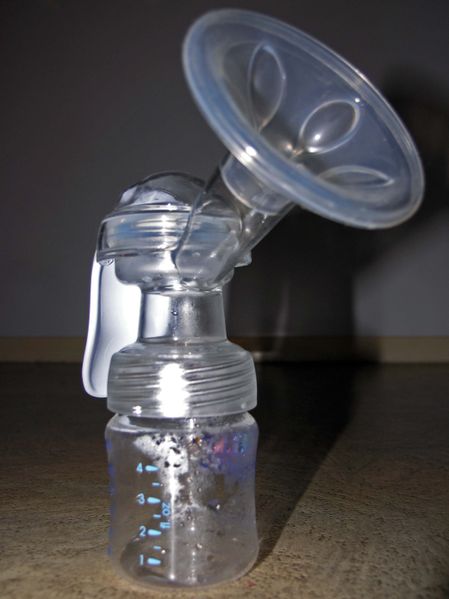Breast pump
Editor-In-Chief: C. Michael Gibson, M.S., M.D. [2] Associate Editor(s)-in-Chief: Template:TarekN
Overview

A breast pump is a mechanical device (powered manually or by electricity) that extracts milk from the breasts of a woman who is lactating. The breast pump was invented and patented by Edward Lasker. Mechanically, a breast pump is directly analogous to a milking machine used in commercial dairy production. A misconception is that the breast pump suctions milk out of the breast. A breast pump's job is to trigger the milk-ejection response or let-down. Most pumps achieve this goal by using suction to pull the nipple into the tunnel of the breast shield or flange then release, which counts as one cycle. Thirty to sixty cycles per minute can be expected with better quality electric breast pumps. It is important to note that in most cases the breast pump is not as efficient at removing milk from the breast as the nursing baby.
The expressed breast milk (EBM) may be stored and later fed to a baby by bottle. Expressed milk may be kept at room temperature for up to ten hours (at 66-72 degrees Fahrenheit, around 20 degrees Celsius), refrigerated for up to 8 days, or frozen for six months in a deep freeze separate from a refrigerator maintained at a temperature of 0 degrees Fahrenheit, −18 degrees Celsius. Expressed milk may be donated to milk banks, which provide human breast milk to premature infants and other high-risk children whose mothers cannot provide for them.
Women use breast pumps for many reasons. Many women use breast pumps to continue breastfeeding after they return to work. They use the pump to express breast milk which is later bottle fed to their child by a caregiver. A breast pump may also be used to stimulate lactation for women with a low milk supply, or who have not just given birth. A breast pump may be used to relieve engorgement, a painful condition whereby the breasts are overfull, possibly preventing a proper latch by the infant. If an infant does not latch properly for direct breastfeeding, and the mother still desires the benefits of breast milk, she may choose to pump exclusively. If the mother needs to take medication that affects the breast milk and may be harmful to the infant, the mother may "pump and dump" the breast milk to keep up her milk supply during the time period that she is on the medication and may resume nursing after the course of medication is completed. Finally, pumping may be desirable to continue lactation and its associated hormones to aid in recovery from pregnancy even if the pumped milk is not used.
Styles of pumps
Manual breast pumps are operated by squeezing a handle in a repetitive fashion, allowing the user to directly control the pressure and frequency of pumps. Though manual pumps are small and inexpensive, they can require significant effort and can be tiring because the user provides all the power. This style is recommended for infrequent usage such as when a woman is away from her baby for a single feeding. It is recommended that "bicycle horn" style manual pumps not be used. Though cheap, they can damage breast tissue and harbor bacteria in the rubber suction bulb, which is difficult to clean.[1]
Electric breast pumps are powered by a small motor which supplies suction through plastic tubing to a horn that fits over the nipple. The portions of the pump that come into direct contact with the expressed milk must be sterilized to prevent contamination. This style provides a lot more suction, making pumping significantly faster, and allows pumping of both breasts at the same time. Electric breast pumps are ideal for when a mother will be pumping daily. Electric breast pumps are larger than manual ones, but portable models are available (e.g. in a backpack or shoulder bag) that allow the mother to transport the pump.
Some breast pumps are designed to be part of a "feeding system" so that the milk storage portion of the pump is the baby bottle used to feed the infant.
Foot-powered breast pumps cover a middle ground between manual and electric breast pumps. They use the same collection tubing and breast horns as electric breast pumps use, but are powered by a foot pedal, eliminating the work of pumping by hand or the need for finding an electrical outlet with privacy.[2]
Open Collection Systems vs. Closed Collection Systems
The plastic tubing and horn of an electric breast pump are commonly referred to as the collection system. When this style of breast pump was originally developed, the pump’s suction was supplied through the collection system tubing. This type of collection system design is now referred to as an open system.
Today most electric breast pumps feature a closed collection system. A closed collection system has a barrier or diaphragm that separates the pump tubing from the horn. In this design, the suction of the pump motor lifts the diaphragm to create a vacuum within the collection system to extract milk.
When an open collection system is used, the pump’s suction can cause milk to overflow into the collection system tubing, which may lead to milk particles being drawn into the pump motor. If milk leaks into the pump’s tubing, the tubes should be washed, sterilized and air-dried prior to using the pump again. Failure to thoroughly clean collection tubing may lead to mold growth within the tubing.
The diaphragm in a closed system eliminates the possibility of milk being able to overflow into the pump tubing. Because milk is unable to be exposed to the pump motor, closed collection systems are considered more hygienic than open collection systems. The barrier in a closed collection system breast pump also prevents outside air from contaminating the expressed breastmilk in the collection bottle, which preserves the milk’s purity.